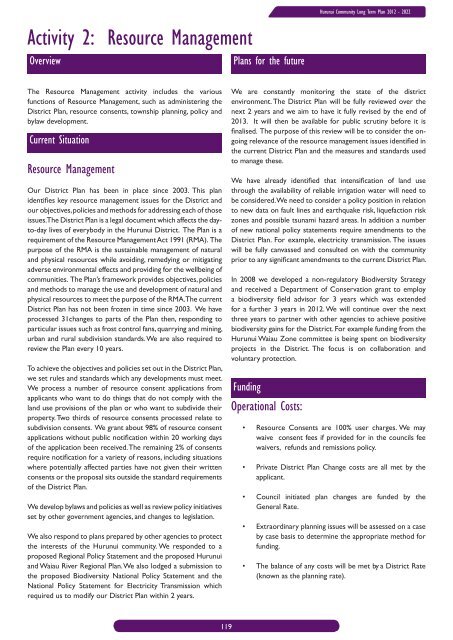Long Term Community Plan 2012-2022 - Hurunui District Council
Long Term Community Plan 2012-2022 - Hurunui District Council
Long Term Community Plan 2012-2022 - Hurunui District Council
Create successful ePaper yourself
Turn your PDF publications into a flip-book with our unique Google optimized e-Paper software.
<strong>Hurunui</strong> <strong>Community</strong> <strong>Long</strong> <strong>Term</strong> <strong>Plan</strong> <strong>2012</strong> - <strong>2022</strong><br />
Activity 2: Resource Management<br />
Overview<br />
<strong>Plan</strong>s for the future<br />
The Resource Management activity includes the various<br />
functions of Resource Management, such as administering the<br />
<strong>District</strong> <strong>Plan</strong>, resource consents, township planning, policy and<br />
bylaw development.<br />
Current Situation<br />
Resource Management<br />
Our <strong>District</strong> <strong>Plan</strong> has been in place since 2003. This plan<br />
identifies key resource management issues for the <strong>District</strong> and<br />
our objectives, policies and methods for addressing each of those<br />
issues. The <strong>District</strong> <strong>Plan</strong> is a legal document which affects the dayto-day<br />
lives of everybody in the <strong>Hurunui</strong> <strong>District</strong>. The <strong>Plan</strong> is a<br />
requirement of the Resource Management Act 1991 (RMA). The<br />
purpose of the RMA is the sustainable management of natural<br />
and physical resources while avoiding, remedying or mitigating<br />
adverse environmental effects and providing for the wellbeing of<br />
communities. The <strong>Plan</strong>’s framework provides objectives, policies<br />
and methods to manage the use and development of natural and<br />
physical resources to meet the purpose of the RMA. The current<br />
<strong>District</strong> <strong>Plan</strong> has not been frozen in time since 2003. We have<br />
processed 31changes to parts of the <strong>Plan</strong> then, responding to<br />
particular issues such as frost control fans, quarrying and mining,<br />
urban and rural subdivision standards. We are also required to<br />
review the <strong>Plan</strong> every 10 years.<br />
To achieve the objectives and policies set out in the <strong>District</strong> <strong>Plan</strong>,<br />
we set rules and standards which any developments must meet.<br />
We process a number of resource consent applications from<br />
applicants who want to do things that do not comply with the<br />
land use provisions of the plan or who want to subdivide their<br />
property. Two thirds of resource consents processed relate to<br />
subdivision consents. We grant about 98% of resource consent<br />
applications without public notification within 20 working days<br />
of the application been received. The remaining 2% of consents<br />
require notification for a variety of reasons, including situations<br />
where potentially affected parties have not given their written<br />
consents or the proposal sits outside the standard requirements<br />
of the <strong>District</strong> <strong>Plan</strong>.<br />
We develop bylaws and policies as well as review policy initiatives<br />
set by other government agencies, and changes to legislation.<br />
We also respond to plans prepared by other agencies to protect<br />
the interests of the <strong>Hurunui</strong> community. We responded to a<br />
proposed Regional Policy Statement and the proposed <strong>Hurunui</strong><br />
and Waiau River Regional <strong>Plan</strong>. We also lodged a submission to<br />
the proposed Biodiversity National Policy Statement and the<br />
National Policy Statement for Electricity Transmission which<br />
required us to modify our <strong>District</strong> <strong>Plan</strong> within 2 years.<br />
We are constantly monitoring the state of the district<br />
environment. The <strong>District</strong> <strong>Plan</strong> will be fully reviewed over the<br />
next 2 years and we aim to have it fully revised by the end of<br />
2013. It will then be available for public scrutiny before it is<br />
finalised. The purpose of this review will be to consider the ongoing<br />
relevance of the resource management issues identified in<br />
the current <strong>District</strong> <strong>Plan</strong> and the measures and standards used<br />
to manage these.<br />
We have already identified that intensification of land use<br />
through the availability of reliable irrigation water will need to<br />
be considered. We need to consider a policy position in relation<br />
to new data on fault lines and earthquake risk, liquefaction risk<br />
zones and possible tsunami hazard areas. In addition a number<br />
of new national policy statements require amendments to the<br />
<strong>District</strong> <strong>Plan</strong>. For example, electricity transmission. The issues<br />
will be fully canvassed and consulted on with the community<br />
prior to any significant amendments to the current <strong>District</strong> <strong>Plan</strong>.<br />
In 2008 we developed a non-regulatory Biodiversity Strategy<br />
and received a Department of Conservation grant to employ<br />
a biodiversity field advisor for 3 years which was extended<br />
for a further 3 years in <strong>2012</strong>. We will continue over the next<br />
three years to partner with other agencies to achieve positive<br />
biodiversity gains for the <strong>District</strong>. For example funding from the<br />
<strong>Hurunui</strong> Waiau Zone committee is being spent on biodiversity<br />
projects in the <strong>District</strong>. The focus is on collaboration and<br />
voluntary protection.<br />
Funding<br />
Operational Costs:<br />
• Resource Consents are 100% user charges. We may<br />
waive consent fees if provided for in the councils fee<br />
waivers, refunds and remissions policy.<br />
• Private <strong>District</strong> <strong>Plan</strong> Change costs are all met by the<br />
applicant.<br />
• <strong>Council</strong> initiated plan changes are funded by the<br />
General Rate.<br />
• Extraordinary planning issues will be assessed on a case<br />
by case basis to determine the appropriate method for<br />
funding.<br />
• The balance of any costs will be met by a <strong>District</strong> Rate<br />
(known as the planning rate).<br />
119

















